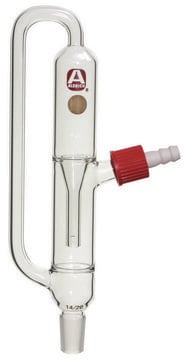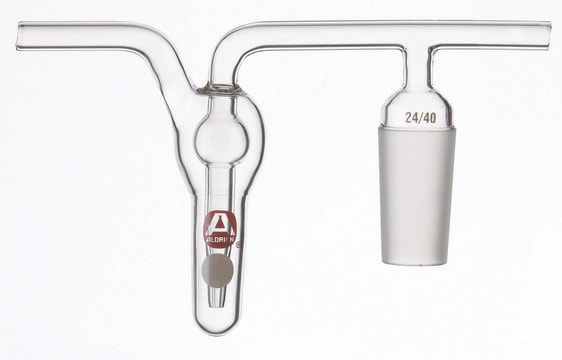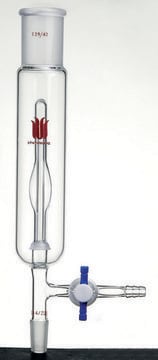Z225010
Aldrich® check-valve bubbler
single-inlet tube, top outlet
Sinónimos:
bubblers, scientific bubblers
Iniciar sesiónpara Ver la Fijación de precios por contrato y de la organización
About This Item
UNSPSC Code:
41121800
NACRES:
NB.43
Productos recomendados
capacity
15 mL
¿Está buscando productos similares? Visita Guía de comparación de productos
Categorías relacionadas
General description
Filling
Position the bubbler on it′s side with the left hose barb (as shown in the drawing) pointing straight up, then pipette 15 mL of oil through the hose barb into the bubbler reservoir. Position bubbler vertically as shown in drawing and it is ready to use.
Principal of operation
Gas enters the bubbler from the hose barb on the right and flows through the bubbler, exiting at the left. The gas pressure unseats the check-valve ball to release the pressure, bubbling up through the oil and out the left side. The check-valve ball reseats itself when pressure is neutralized. The advantage of a check-valve over bubbler such as Z223719 which does not have one, is that it prevents oil from being drawn from the bubbler reservoir into the reaction if a sudden negative pressure occurs.
Position the bubbler on it′s side with the left hose barb (as shown in the drawing) pointing straight up, then pipette 15 mL of oil through the hose barb into the bubbler reservoir. Position bubbler vertically as shown in drawing and it is ready to use.
Principal of operation
Gas enters the bubbler from the hose barb on the right and flows through the bubbler, exiting at the left. The gas pressure unseats the check-valve ball to release the pressure, bubbling up through the oil and out the left side. The check-valve ball reseats itself when pressure is neutralized. The advantage of a check-valve over bubbler such as Z223719 which does not have one, is that it prevents oil from being drawn from the bubbler reservoir into the reaction if a sudden negative pressure occurs.
Legal Information
Aldrich is a registered trademark of Sigma-Aldrich Co. LLC
Certificados de análisis (COA)
Busque Certificados de análisis (COA) introduciendo el número de lote del producto. Los números de lote se encuentran en la etiqueta del producto después de las palabras «Lot» o «Batch»
¿Ya tiene este producto?
Encuentre la documentación para los productos que ha comprado recientemente en la Biblioteca de documentos.
Los clientes también vieron
Nuestro equipo de científicos tiene experiencia en todas las áreas de investigación: Ciencias de la vida, Ciencia de los materiales, Síntesis química, Cromatografía, Analítica y muchas otras.
Póngase en contacto con el Servicio técnico















